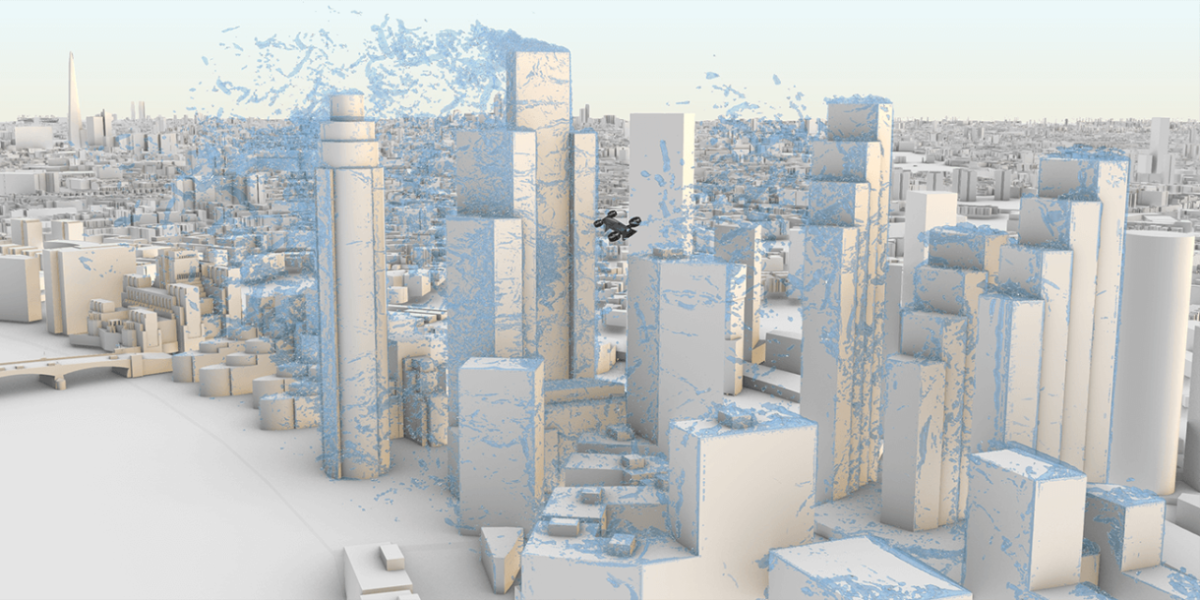Urban Air Mobility: A Wind Engineering Perspective
Enabling urban air mobility to weather the storm
By Stefano Cammelli
Urban air mobility (UAM) is an emerging concept in air transportation featuring highly automated aircraft that are expected to include a mix of piloted, remotely piloted, and fully autonomous vehicles. The aim of UAM is to provide a wide range of services—intracity and intercity—including on-demand air taxis, air shuttles, cargo air vehicles, and medical emergency services.
With an ever-growing urban population around the world, cities and megacities will inevitably look at UAM as an alternative transportation mode to help reduce pollution levels, improve connectivity, and reduce strain on existing transport networks.
In the context of UAM, electric-powered vertical take-off and landing aircraft, known as eVTOLs, provide perfect mobility solutions for densely built-up urban environments. Despite the significant technological advancements made in the UAM industry in recent years, wind remains the most challenging natural physical phenomena confronting eVTOL aircraft.
Weather events as well as their complex interaction with cities and megacities have the potential to influence many aspects of UAM, including safety, operations and passenger comfort. Disruptions caused by strong winds, wind shear and turbulence can impact the operational down-time of eVTOLs, and the frequency of thunderstorm events could also dictate the financial viability of UAM operations in certain cities.
Generally, in urban environments, the building-induced hazards that arise from complex wind conditions near high-rise buildings will need to be taken into consideration during the planning stage of flightpaths and vertiport siting.
Integral to Planning and Operations
MODELLING AND SIMULATIONS
Within the modelling and simulation design space, advanced and extensive city-level as well as vertiport site-specific wind studies will be required—to quantify complex airflow patterns within the urban canopy, to assess the risk associated with atmospheric turbulence, and to assess the risk associated with proximity to high-rise buildings, particularly in relation to flight operations.
An initial assessment of city-level historical weather conditions—with a focus on the frequency of existing weather-related risks and their potential impact on operations and availability of service—will be crucial to support planning and inform investment decisions.
PREDICTIVE DESIGN TOOLS
Design tools such as boundary layer wind tunnel testing and cloud-based computational fluid dynamics (CFD) simulations will need to be employed to quantify the complex city- and vertiport-specific three-dimensional turbulent flow features that are inherent in the urban canopy of modern cities and megacities and to ensure that building-induced hazards are taken into consideration. Wind tunnel testing will rely on the use of flow measurement techniques such as particle image velocimetry (PIV), whilst CFD simulations will rely on scale-resolving simulations (SRS) such as large eddy simulation (LES) or detached eddy simulations (DES). The results of these predictive tools will need to be frequently updated to take into account that cityscapes are not static entities.
Data collected experimentally (wind tunnel testing) and numerically (CFD simulations) could also be used to drive motion simulation testing to obtain pilots/passengers feedback, determine practical turbulence thresholds for safe and comfortable flight operations and deliver vertiport-specific training to pilots.
Figure 1 and Figure 2 show some of the visual outputs that can be obtained from detailed DES simulations.
Types of Wind Challenges
WEATHER
With cruise altitude expected to cap at approximately 5,000 feet, eVTOLs will largely be spending their life in the lowest portion of the troposphere—within the so-called ‘atmospheric boundary layer’. Turbulence within this space is generated as the wind blows over the earth's surface as well as by thermal buoyancy.
When winds are strong, the turbulence that is generated by the terrain roughness (e.g., buildings, trees) prevails. In this scenario, winds near the ground will be far more turbulent than the ones at several feet above street level; and winds blowing over large cities will be far more turbulent than, for example, the ones coming off the ocean.
Despite being chaotic in nature, turbulence can be thought as the superposition of many whirls of air of varying sizes, often referred to as ‘eddies’; an eVTOL, for example, will be particularly susceptible to eddies of a size that is either comparable or larger than the size of the aircraft itself. This means that the smaller the size of an aircraft, the more sensitive the aircraft will be to weather-related hazards as it will be susceptible to a much broader range of eddies.
The weather conditions within the airspace that will be occupied by eVTOLs will not only be influenced by the passage of low-pressure systems such as depressions or tropical cyclones, but also by far more dangerous and somewhat less well-understood thunderstorm-driven gust fronts.
URBAN ENVIRONMENT
It is expected that eVTOLs will cruise within a certain UAM corridor at an altitude below the airway of conventional aircraft. These small aircraft will then be relying on a network of vertiports which will provide the necessary infrastructure for landing, recharging, and taking-off—a network that will need to be integrated within the urban canopy of existing and future cities and megacities.
When air flows over a city, there are several complex flow features that can produce rapid changes of speed and turbulence along certain flightpaths and result in a sudden drop in aerodynamic lift—these include wakes behind buildings, downdrafts, updrafts, funnelling between neighbouring buildings, shear layers close to the building corners, and horseshoe vortices.
Vertiports will need to be equipped with automated weather stations, LiDAR systems and wind profilers to provide automatic weather alerts and to inform vital no-go decisions. A network of meteo-drones will be needed to support weather-forecasting models. eVTOLs may also be equipped with sensors capable of measuring, whilst flying, the complex flow features that are typical of wind moving around buildings. These measurements will improve weather forecasting within urban environments, allowing the near-real-time performance predictions of the three-dimensional turbulent flow characteristics along the various flightpaths to be made available to all flying aircraft.
***
The size and light-weight nature of eVTOLs make them inherently more susceptible to gusty winds than conventional aircraft. Understanding and predicting how wind moves and swirls within an urban environment is therefore critical to ensure that wind-related risks will be minimised. Specialised wind engineering studies play a vital role in providing the technical expertise the global UAM industry requires to grow to its full potential.




